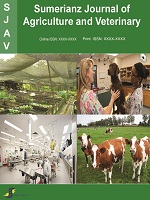Sumerianz Journal of Agriculture and Veterinary

Online ISSN: 2617-3077
Print ISSN: 2617-3131
Quarterly Published (4 Issues Per Year)
Journal Website: https://www.sumerianz.com/?ic=journal-home&journal=30Archive
Volume 2 Issue 11 (2019)
Evaluations of Some Heavy Metals in Some Vegetables Cultivated in Two Villages in Damboa, Nigeria
Authors : Gwana Adamu Mohammed ; Kolo Baba Gana ; Halima Bala Mohammed ; Mu’azu Abdullahi Kofar Na’isa ; Abubakar Aliyu ; Hamra Abatcha Ahmed ; Baba Mala Mustapha ; M0hammed Lawan Marte
Abstract:With regard to food security and its hazards, and environmental impacts, this research study was carried out to determine the concentration of some heavy metals in some vegetables that are cultivated in some villages in Damboa, Nigeria. Fresh samples of spinach (Amaranth caudatus) and lettuce (lactuca sativa) were obtained from the farms in triplicates, in two villages, were placed each in polythene bags, labelled, transported to the Laboratory and were analysed by using Atomic Absorption Spectrophotometric techniques. The results obtained, revealed a variation in mean concentration of heavy metals analysed (Cd, Cr, Cu, Fe, Mn, Ni, Pb and Zn), were obtained in µg / L and %. Katchalla-Bulari village; lettuce ranged from -1.00 ± 0.06 to 1.07 ± 0.01 µg / L (- 38.5 to 41.2 %), the highest concentration level is Iron (Fe) and least is Lead (Pb), spinach ranged from -0.40 ± 0.06 to 1.33 ± 0.02 µg / L (- 8.9 to 29.6 %), the highest concentration level is Iron (Fe) and least is Lead (Pb), same as in lettuce. Nziddamari village; lettuce ranged from 0.08 ± 0.02 to 2.10 ± 0 and 2.10 ± 0.1 µg / L (1.1 to 29.5 %), the highest concentration level is Fe and Pb which have same value, and least is chromium (Cr). While in spinach it ranged from 0.10 ± 0.01 to 2.10 ± 0.1 µg / L (2.0 to 41.2 %), the highest is Fe and Pb being the least. The values were within the recommended values by WHO / FAO standard. Thus, the vegetable cultivated in these two villages, Damboa area were found to be wholesome and fit for consumption as at the time of this findings.
Comparison of Nutrient Combinations for Enhanced Groundnut (Arachis Hypogaea L.) Productivity in a Dryland Ecology
Authors : B. Goni ; S. G. Mohammed ; H. A. Daya ; I. B. Kumshe
Abstract:Farmers in the savannas of Nigeria usually do not apply any form of mineral fertilizers to groundnut crops due to high cost, inadequacy of the fertilizers or due to the long-held belief that groundnuts do not require external application of fertilizers. Trials were conducted during the 2015 rainy season on farmers’ fields in 15 villages across 3 Local Government Areas (LGAs) of Kano State to study the effects of various nutrient applications and combinations on groundnut productivity. The treatments were P only, P + K, P + K + Micronutrients (Mc), P + K + Mc + Organic manure (OM), OM only and no fertilizer treatment (Control). The treatments were laid out in a Randomized Complete Block Design with farmers as replicates. The results showed that nutrient applications whether singly or in combinations had positive influences on yield and yield attributes of groundnut across the LGAs. Plant height was the only variable affected by the nutrient combinations where P+K+Mc+OM produced the tallest plants, while the Control produced the shortest plants. Days to flowering were statistically similar in Ajingi and Gezawa but longer in Gaya. Significantly higher number of pods, pod and haulm yields, shelling %, and 100 kernel weights were recorded in Gezawa. Lowest number of pods, pod and haulm yields, were recorded in Gaya. Significant interactions between the treatments and LGAs were recorded for pod and haulm yields.



